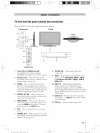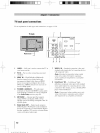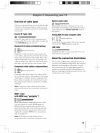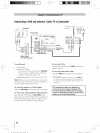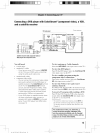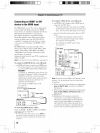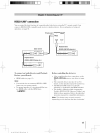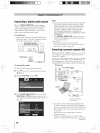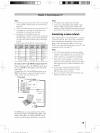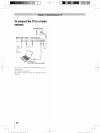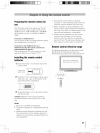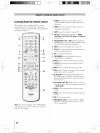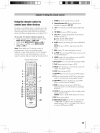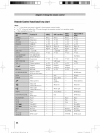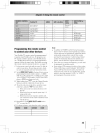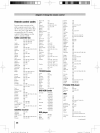
No te:
• The PCaudio input terminals on the TVare shared
with the HDMI-1analog audio input terminals (_,,_
page 50).
• Some PC models cannot be connected to this TX
• An adapter is not needed for corrputers with a
compatible mini D-sub 15-pinterminal.
Depending on the DVD'stitle and the
specifications of the PC on which you are playing
the DVD-Video, some scenes may be skipped or
you may not be able to pause during multi-angle
scenes.
• Signal names for mini D-sub 15-pin connector
1 R 6 Ground 11 Reserved
2
3
4
5
G 7 Ground 12 SDA
B 8 Ground 13 H-sync
Reserved 9 5V 14 V-sync
Reserved 10 Ground 15 SCL
To connect a PC to the HDMI termina| on the TV:
When connecting a PC to the HDM[ terminal on the
TV, use an HDM[-to DVI[adapter cable and analog
audio cables.
[f connecting a PC with an HDM[ terminal, use an
HDM[ cable (type A connector). Separate analog
cables are not necessary (_:_>page 16).
TVbackpanel
No te:
• Theedges of theimages may be hidden.
• If receiving a480i (HDMI),480p (HDMI), 720p,
1080Lor 1080p signal program, Native mode
scales the video to display theentirepicture within
the borders of the screen (Le. no overscanning).
Connectinga homenetwork
The LAN port allows your Toshiba TV to connect to
your home network. You can use this revolutionary
home entertainment networking system to access
photo, video and audio files that are stored on a
DLNA server aim play/display them on your TV. For
supported formats, see page 53.
Note:
° The TV'shome network connection allows
access to file sharing only, You will NOTbe
able to use the TV to access the Intemet.
° Ifyou use a hub or switch to connect the
TV to your home network, you may not be
able to use the automatic setup and have to
manually set up the network address. See
page 55.
° Ifyou use a router with built-in DHCP
functionality, use the automatic setup.
Manual setup may not work.
,, Ifyou connect the TV and PC directly, use
Ethernet crossover cable.
cable
The HDMI inputcan accept and display VGA, SVGA,
XGA, WXGA, SXGA,48@(60Hz), 480p (60Hz), 720p
(60Hz), 1080i (60Hz), and 10S0p(24Hz/60Hz) signal
formats. For detailed signal specifications, see page 66.
19
40 ,46550300UBNASindb 19 2010/,4/16 T@05:43:25



